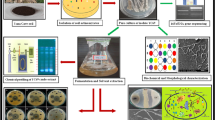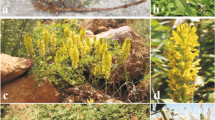Abstract
The present work aimed to evaluate the effects of commercial fungicides containing the active compounds from the triazole group—tebuconazole (TBZ) and difenoconazole (DFZ)—and dicarboximide group—procymidone (PRD) and iprodione (IPD) on the mitotic cycle of the plant model Lactuca sativa L. These active compounds have been present in foods sampled at different Brazilian’s states and amounted higher than recommended by law. The bioassay with L. sativa was applied to access the toxicity and better understand the mechanisms of action of these compounds in living beings. The active principles IPD and DFZ presented mitodepressive effect, statistically reducing the MI at all applied concentrations in comparison to the negative control. TBZ was the most cytotoxic active compound tested inhibited in 77% mitotic active in the lowest concentration applied. PRD alter the frequency of mitotic cells only in the concentration above that recommended by the manufacture. C-metaphase and adherent chromosomes were the most frequent cell cycle alteration observed on the treated cells, followed by bridges and lost chromosomes. Therefore, the mechanism of action was mainly aneugenic (70%). For TBZ, the frequency of condensed nucleus was very expressive (313 higher than the negative control).

Similar content being viewed by others
References
Acquaviva, C., & Pines, J. (2006). The anaphase-promoting complex/cyclosome: APC/C. Journal of Cell Science, 119, 2401–2404.
Andrade-Vieira, L. F., Gedraite, L. S., Campos, J. M. S., & Davide, L. C. (2011). Spent pot liner (SPL) induced DNA damage and nuclear alterations in root tip cells of Allium cepa as a consequence of programmed cell death. Ecotoxicology and Environmental Safety. https://doi.org/10.1016/j.ecoenv.2010.12.010.
Andrade-Vieira, L. F., de Campos, J. M. S., & Davide, L. C. (2012). Effects of spent pot liner on mitotic activity and nuclear DNA content in meristematic cells of Allium cepa. Journal of Environmental Management. https://doi.org/10.1016/j.jenvman.2012.04.008.
Andrade-Vieira, L. F., Botelho, C. M., Laviola, B. G., Palmieri, M. J., & Praça-Fontes, M. M. (2014). Effects of Jatropha curcas oil in Lactuca sativa root tip bioassays. Anais da Academia Brasileira de Ciências, 86(1), 373–382.
Anvisa - Agência Nacional de Vigilância Sanitária. (2013). Programa de Análise de Resíduos de Agrotóxicos em Alimentos (PARA). http://portal.anvisa.gov.br/wps/wcm/ connect/d480f50041ebb7a09db8bd3e2b7e7e4d/Relat%C3% 3rio%2BPARA%2B2011–12%2B-%2B30_10_13_1.pdf? MOD=AJPERES). Accessed 11 Jan 2016.
Aragão, F. B., Queiroz, V. T., Ferreira, A., Costa, A. V., Pinheiro, P. F., Carrijo, T. T., & Andrade-Vieira, L. F. (2017). Phytotoxicity and cytotoxicity of Lepidaploa rufogrisea (Asteraceae) extracts in the plant model Lactuca sativa (Asteraceae). Revista De Biologia Tropical. https://doi.org/10.15517/rbt.v65i2.25696.
Baderna, D., Maggioni, S., Boriani, E., Gemma, S., Molteni, M., Lombardo, A., Colombo, A., Bordonali, S., Rotella, G., Lodi, M., & Benfenati, E. (2011). A combined approach to investigate the toxicity of an industrial landfill’s leachate: chemical analyses, risk assessment and in vitro assays. Environmental Research. https://doi.org/10.1016/j.envres.2011.01.015.
Bernardes, P. M., Andrade-Vieira, L. F., Aragão, F. B., Ferreira, A., & Da Silva Ferreira, M. F. (2015). Toxicity of difenoconazole and tebuconazole in Allium cepa. Water, Air, and Soil Pollution. https://doi.org/10.1007/s11270-015-2462-y.
Bianchi, J., Cabral-de-Mello, D. C., & Marin-Morales, M. A. (2015). Toxicogenetic effects of low concentrations of the pesticides imidacloprid and sulfentrazone individually and in combination in in vitro tests with HepG2 cells and Salmonella typhimurium. Ecotoxicology and Environmental Safety. https://doi.org/10.1016/j.ecoenv.2015.05.040.
Bianchi, J., Casimiro Fernandes, T. C., & Marin-Morales, M. A. (2016). Induction of mitotic and chromosomal abnormalities on Allium cepa cells by pesticides imidacloprid and sulfentrazone and the mixture of them. Chemosphere. https://doi.org/10.1016/j.chemosphere.2015.09.021.
Campos, J. M. S., Viccini, L. F., Andrade, L. F., & Davide, L. C. (2008). Genetic toxicology and environmental mutagenesis in allelopathic interactions (1st ed.). Houston: Studium Press.
Caritá, R., & Marin-Morales, M. A. (2008). Induction of chromosome aberrations in the Allium cepa test system caused by the exposure of seeds to industrial effluents contaminated with azo dyes. Chemosphere. https://doi.org/10.1016/j.chemosphere.2008.03.056.
Carson, R. (2010). Primavera Silenciosa (1st ed.). São Paulo: Gaia.
de Campos, J. M. S., Davide, L. C., Soares, G. L. G., & Viccini, L. F. (2008). Mitodepressive and clastogenic effects of aqueous extracts of the lichens Myelochroa lindmanii and Canoparmelia texana (Lecanorales, Parmeliaceae) on meristematic cells in plant bioassays. Genetics and Molecular Biology. https://doi.org/10.1590/S1415-47572008000100024.
Fernandes, T. C. C., Mazzeo, D. E. C., & Marin-Morales, M. A. (2007). Mechanism of micronuclei formation in polyploidizated cells of Allium cepa exposed to trifluralin herbicide. Pesticide Biochemistry and Physiology. https://doi.org/10.1016/j.pestbp.2006.12.003.
Fernandes, T. C. C., Mazzeo, D. E. C., & Marin-Morales, M. A. (2009). Origin of nuclear and chromosomal alterations derived from the action of an aneugenic agent-trifluralin herbicide. Ecotoxicology and Environmental Safety. https://doi.org/10.1016/j.ecoenv.2009.03.014.
Fiskesjö, G. (1985). The Allium test as a standard in environmental monitoring. Hereditas. https://doi.org/10.1111/j.1601-5223.1985.tb00471.x.
Fiskesjö, G. (1993). The Allium test—A potential standard for the assessment of environmental toxicity. In Environmental toxicology and risk assessment: second volume. ASTM international (pp.15). Lundiana.
Freitas, L. B. O., Ruela, F. A., Pereira, G. R., Alves, R. B., Freitas, R. P., & Santos, L. J. (2011). A reação “click” na síntese de 1, 2, 3-triazóis: aspectos químicos e aplicações. Química Nova, 34, 1791–1804.
Freitas, A. S., Fontes Cunha, I. M., Andrade-Vieira, L. F., & Techio, V. H. (2016). Effect of SPL (spent pot liner) and its main components on root growth, mitotic activity and phosphorylation of histone H3 in Lactuca sativa L. Ecotoxicology and Environmental Safety. https://doi.org/10.1016/j.ecoenv.2015.11.017.
Grant, W. F. (1994). The present status of higher plant bioassays for the detection of environmental mutagens. Mutation Research - Fundamental and Molecular Mechanisms of Mutagenesis. https://doi.org/10.1016/0027-5107(94)90112-0.
Grant, W. F. (1999). Higher plant assays for the detection of chromosomal aberrations and gene mutations-a brief historical background on their use for screening and monitoring environmental chemicals. Mutation Research - Fundamental and Molecular Mechanisms of Mutagenesis. https://doi.org/10.1016/S0027-5107(99)00050-0.
Leme, D. M., & Marin-Morales, M. A. (2009). Allium cepa test in environmental monitoring: a review on its application. Mutation Research/Reviews in Mutation Research. https://doi.org/10.1016/j.mrrev.2009.06.002.
Matoba, H., Mizutani, T., Nagano, K., Hoshi, Y., Uchiyama, H. (2007). Chromosomal study of lettuce and its allied species (Lactuca spp., Asteraceae) by means of karyotype analysis and fluorescence in situ hybridization. Hereditas. https://doi.org/10.1111/j.2007.0018-0661.02012x.
Mauro, M. O., Pesarini, J. R., Marin-Morales, M. A., Monreal, M. T. F. D., Monreal, A. C. D., & Oliveira, R. J. (2014). Evaluation of the antimutagenic activity and mode of action of carrageenan fiber in cultured meristematic cells of Allium cepa. Genetics and Molecular Research. https://doi.org/10.4238/2014.November.12.1.
Narwal, S. S., Sampietro, D. A., Cataán, C. A. A. (2008) Laboratory bioassays in allelopathy. In: Narwal SS, Catalán CAN, Sampietro DA et al (eds) Plant bioassays (pp 1–344). Studium press, Houston.
Palmieri, M. J., Andrade-Vieira, L. F., Trento, M. V. C., de Faria Eleutério, M. W., Luber, J., Davide, L. C., & Marcussi, S. (2016). Cytogenotoxic effects of spent pot liner (SPL) and its main components on human leukocytes and meristematic cells of Allium cepa. Water, Air, and Soil Pollution. https://doi.org/10.1007/s11270-016-2809-z.
PPDB: Pesticida Properties DataBase. https://sitem.herts.ac.uk/aeru/ppdb/en/. Accessed 10 September 2017.
R, Development Core Team. (2011). A language and environment for statistical computing. R Foundation for Statistical Computing.
Seesp - Sindicato dos Engenheiros no Estado de São Paulo. (2014). Sinal de alerta ao uso e consumo de agrotóxico no Brasil. http://www.seesp.org.br/site/imprensa/noticias/item/5248-sinal-de-alerta-ao-uso-e-consumo-de-agrot%C3%B3xico-no-brasil.html. Accessed 06 April 2015.
Silveira, G.L., Lima, M.G.F., Reis, G.B. dos, Palmieri, M.J., Andrade-Vieria, L.F. (2017). Toxic effects of environmental pollutants: Comparative investigation using Allium cepa L. and Lactuca sativa L. chemosphere, https://doi.org/10.1016/j.chemosphere.2017.03.048.
Soares, A. F. S. (2011) Uso de agrotóxicos, contaminação de mananciais e análise da legislação pertinente [manuscrito]: um estudo na região de Manhuaçu – MG. http://www.bibliotecadigital.ufmg.br/dspace/handle/1843/ENGD-8RAMAP. Accessed 05 October 2016.
Sudakin, V., Chan, G. K., & Yen, T. J. (2001). Checkpoint inhibition of the APC/C in HeLa cells is mediated by a complex of BUBR1, BUB3, CDC20, and MAD2. Journal of Cell Biology. https://doi.org/10.1083/jcb.200102093.
Zambolim, L., Picanço, M. C., Silva, A. D., Ferreira, I. R., Ferreira, F. A., & Jesus-Junior, W. C. (2008). Produtos Fitossanitários (fungicidas, inseticidas, acaricidas e herbicidas). Viçosa: DFP.
Author information
Authors and Affiliations
Corresponding author
Additional information
Publisher’s Note
Springer Nature remains neutral with regard to jurisdictional claims in published maps and institutional affiliations.
Rights and permissions
About this article
Cite this article
Aragão, F.B., Bernardes, P.M., Ferreira, A. et al. Cyto(geno)toxicity of Commercial Fungicides Based on the Active Compounds Tebuconazole, Difenoconazole, Procymidone, and Iprodione in Lactuca sativa L. Meristematic Cells. Water Air Soil Pollut 230, 25 (2019). https://doi.org/10.1007/s11270-019-4080-6
Received:
Accepted:
Published:
DOI: https://doi.org/10.1007/s11270-019-4080-6




